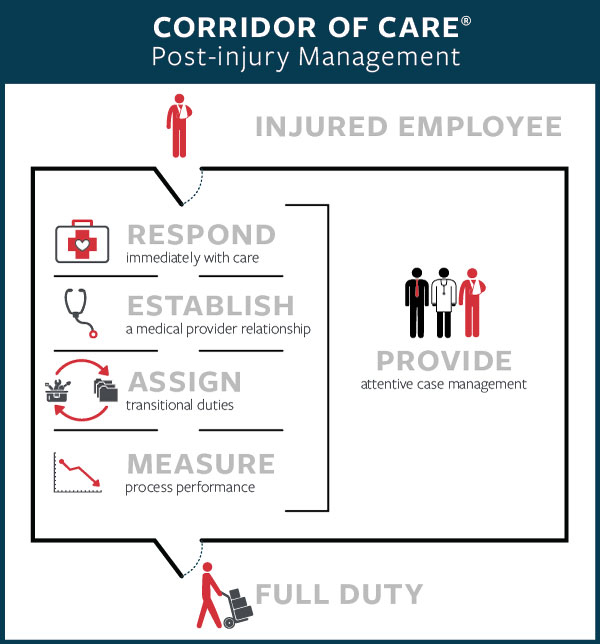Injury Management Strategy and Planning

For most employees, being injured on the job is a first-time occurrence, and the road back to work is not always well defined. Employee injuries should never be considered routine; however, your response plan should be.
The Travelers Corridor of Care® post-injury management process is a carefully structured sequence of activities designed to take care of the injured employee from the moment of injury through return to full duty.
Our process can help you reduce the cost of workers compensation losses by building a systematic and positive approach to handling employee injuries.
Five Strategies of Post-Injury Management
- Respond immediately to injury. When an employee is injured, you should respond in a caring and non-judgmental way, and help him or her receive the care he or she needs as soon as possible. Once the injured employee is receiving care, you should begin your accident investigation.
- Establish a medical provider relationship. Partner with a medical provider who understands your company and your post-injury management process.
- Assign transitional duties. When employees feel valued and productive, the severity of claims can be lessened. By offering injured employees an effective transitional-duty program, you can help to build employee morale, keep injured workers connected to the workforce and return to full duty as soon as medically possible. This also can help lower workers compensation costs.
- Provide attentive case management. Designate one person to coordinate all claims management activities with the medical provider, insurer, injured worker, co-workers and line management to help resolve any issues, concerns or impediments to the injured worker’s recovery.
- Measure process performance. You can test your goals against actual performance. Measuring the success of your post-injury management process can help to identify trends for further risk and loss reduction strategies.
Corridor of Care® Post-Injury Management Process
The injured employee is not the only one who suffers. Employees suffer with the pain and discomfort of the injury, as well as the financial loss. Employers can suffer from the disruption in production, quality and morale.
By having a systematic and caring process, you can bring that person into your "Corridor of Care" and actively manage his or her return to full duty. Utilizing best practices to the fullest extent may allow you, the employer, to control your workers compensation costs.




